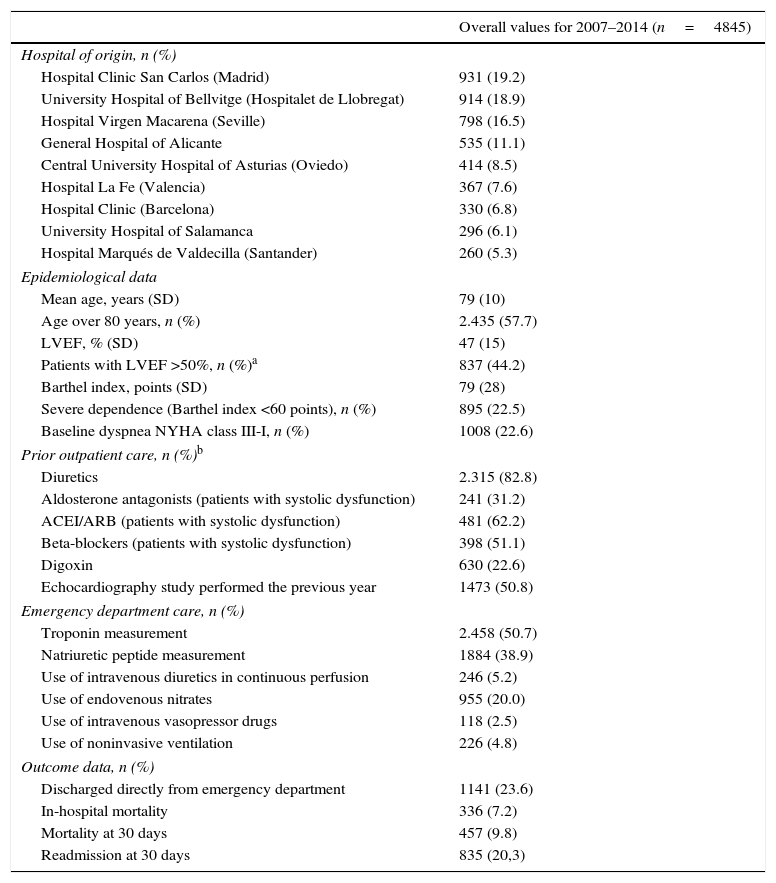To analyze the changes in epidemiology, outpatient and emergency department clinical care, and outcomes of patients treated for acute heart failure (AHF) in Spanish hospital emergency departments (HEDs) between 2007 and 2014.
MethodA multicentre cohort study was conducted that consecutively included patients with AHF diagnosed in 9HEDs during 4 periods (2007, 2009, 2011 and 2014). The study analyzed the changes observed in 20 variables corresponding to baseline data, outpatient care and emergency care data and outcome data.
ResultsA total of 4845 patients were included. There were significant changes in 13 variables: there was an increase in patients older than 80years (2007/2014: 45.9%/55.4%; p<.001) and a decrease in severe functional dependence (28.2%/19.7%; p<.001). In terms of long-term outpatient care, there was an increased use of beta-blockers (44.6%/57.8%; p=.002) and aldosterone antagonists (26.6%/37.7%; p<.05) among patients with reduced ejection fraction and an increase use of echocardiography (42.8%/56.2%; p=.001). The use of digoxin decreased (25.4%/16.9%; p=.005). In terms of emergency care, there was an increase in requests for troponins (54.6%/61.9%; p<.001), natriuretic peptides (7.8%/48.5%; p<.001) and the use of noninvasive ventilation (3.2%/6.9%; p=.004). Requests for endovenous perfusion drugs decreased (diuretics: 21.3%/10.4%; p<.001; nitrates: 21.3%/17.5%; p=.001; vasopressors: 4.2%/1.5%; p<.001). Finally, discharges directly from the emergency department without hospitalization increased (20.0%/25.9%; p<.001), and emergency department readmissions at 30days decreased (27.3%/17.6%; p=.007). Hospital mortality and mortality at 30days did not change.
ConclusionsChanges in outcomes were detected during a 7-year period in patients with AHF treated in HEDs, with care that was more in line with the clinical guidelines. There are, however, areas for improvement. There was a noteworthy increase in outpatient follow-up without hospitalization and a reduction in HED readmissions.
Analizar los cambios en la epidemiología, en la atención clínica ambulatoria y en urgencias, y la evolución de los pacientes atendidos por insuficiencia cardiaca aguda (ICA) en los servicios de urgencias hospitalarios (SUH) españoles entre 2007 y 2014.
MétodoEstudio multicéntrico, de cohortes, con inclusión consecutiva de pacientes con ICA diagnosticados en 9SUH durante 4 periodos (2007, 2009, 2011 y 2014). Se analizaron los cambios observados en 20 variables correspondientes a datos basales, de atención ambulatoria y urgente, y evolutivos.
ResultadosSe incluyeron 4.845 pacientes. Hubo cambios significativos en 13 variables: aumentaron los pacientes >80años (2007/2014: 45,9/55,4%; p<0,001) pero disminuyó la dependencia funcional grave (28,2/19,7%; p<0,001). Respecto a la atención crónica ambulatoria, aumentó el uso de betabloqueantes (44,6/57,8%; p=0,002) y antialdosterónicos (26,6/37,7%; p<0,05) en pacientes con fracción de eyección disminuida, así como la realización de ecocardiografía (42,8/56,2%; p=0,001), y disminuyó el uso de digoxina (25,4/16,9%; p=0,005). En lo referente a la asistencia en urgencias, se incrementó la solicitud de troponinas (54,6/61,9%; p<0,001), péptidos natriuréticos (7,8/48,5%; p<0,001) y el uso de ventilación no invasiva (3,2/6,9%; p=0,004), y disminuyó la de fármacos en perfusión intravenosa (diuréticos: 21,3/10,4%; p<0,001; nitratos: 21,3/17,5%; p=0,001; vasopresores: 4,2/1,5%; p<0,001). Finalmente, aumentaron las altas directas desde urgencias sin hospitalización (20,0/25,9%; p<0,001) y disminuyeron las reconsultas a urgencias a 30días (27,3/17,6%; p=0,007). La mortalidad intrahospitalaria y a los 30días no se modificaron.
ConclusionesSe detectan cambios evolutivos durante un periodo de 7años en los pacientes con ICA atendidos en el SUH, con una asistencia más ajustada a las guías clínicas, aunque todavía existen áreas de mejora. Destaca un aumento del seguimiento ambulatorio sin ingreso, con una disminución de las reconsultas al SUH.
Article
Diríjase desde aquí a la web de la >>>FESEMI<<< e inicie sesión mediante el formulario que se encuentra en la barra superior, pulsando sobre el candado.

Una vez autentificado, en la misma web de FESEMI, en el menú superior, elija la opción deseada.

>>>FESEMI<<<











